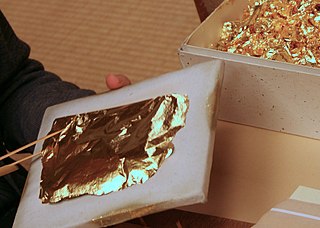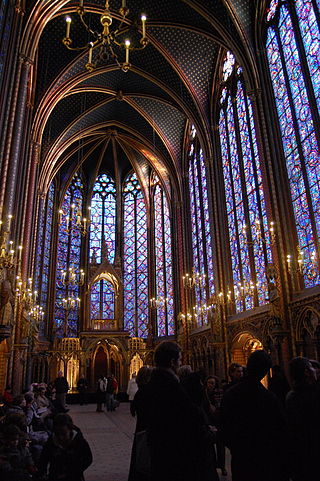Frame conservation is the preservation of picture frames. This involves replicating missing decorative elements, cleaning, gilding, and toning frame surfaces. [1]
Frame conservation is the preservation of picture frames. This involves replicating missing decorative elements, cleaning, gilding, and toning frame surfaces. [1]

Gilding, in the context of frame preservation, describes the process by which metal leaf is applied to a frame to restore areas of the preexisting leaf, that have damage. [2]

Gilding is a decorative technique for applying a very thin coating of gold over solid surfaces such as metal, wood, porcelain, or stone. A gilded object is also described as "gilt". Where metal is gilded, the metal below was traditionally silver in the West, to make silver-gilt objects, but gilt-bronze is commonly used in China, and also called ormolu if it is Western. Methods of gilding include hand application and gluing, typically of gold leaf, chemical gilding, and electroplating, the last also called gold plating. Parcel-gilt objects are only gilded over part of their surfaces. This may mean that all of the inside, and none of the outside, of a chalice or similar vessel is gilded, or that patterns or images are made up by using a combination of gilt and ungilted areas.

A metal leaf, also called composition leaf or schlagmetal, is a thin foil used for gilding and other forms of decoration. Metal leaves can come in many different shades, due to the composition of the metal within the metal leaf. Examples of this variation of shades in metal leaves can be found in Ancient Egyptian gold leaves, as the silver content within the gold leaves could make them appear bright yellow or paler shades of yellow. Some metal leaves may look like gold leaf but do not contain any real gold. This type of metal leaf is often referred to as imitation leaf.

Verre églomisé is a French term referring to the process of applying both a design and gilding onto the rear face of glass to produce a mirror finish. The name is derived from the 18th-century French decorator and art-dealer Jean-Baptiste Glomy (1711–1786), who was responsible for its revival.

A picture frame is a protective and decorative edging for a picture, such as a painting or photograph. It makes displaying the work safer and easier and both sets the picture apart from its surroundings and aesthetically integrates it with them.
The conservation and restoration of new media art is the study and practice of techniques for sustaining new media art created using from materials such as digital, biological, performative, and other variable media.

The conservation and restoration of parchment constitutes the care and treatment of parchment materials which have cultural and historical significance. Typically undertaken by professional book and document conservators, this process can include preventive measures which protect against future deterioration as well as specific treatments to alleviate changes already caused by agents of deterioration.
The conservation and restoration of illuminated manuscripts is the care and treatment of illuminated manuscripts which have cultural and historical significance so that they may be viewed, read, and studied now and in the future. It is a specialty case of the conservation and restoration of parchment within the field of conservation and restoration of books, manuscripts, documents and ephemera.

A conservator-restorer is a professional responsible for the preservation of artistic and cultural artifacts, also known as cultural heritage. Conservators possess the expertise to preserve cultural heritage in a way that retains the integrity of the object, building or site, including its historical significance, context and aesthetic or visual aspects. This kind of preservation is done by analyzing and assessing the condition of cultural property, understanding processes and evidence of deterioration, planning collections care or site management strategies that prevent damage, carrying out conservation treatments, and conducting research. A conservator's job is to ensure that the objects in a museum's collection are kept in the best possible condition, as well as to serve the museum's mission to bring art before the public.

Stained glass conservation refers to the protection and preservation of historic stained glass for present and future generations. It involves any and all actions devoted to the prevention, mitigation, or reversal of the processes of deterioration that affect such glassworks and subsequently inhibit individuals' ability to access and appreciate them, as part of the world's collective cultural heritage. It functions as a part of the larger practices of cultural heritage conservation (conservation-restoration) and architectural conservation.

A conservation scientist is a museum professional who works in the field of conservation science and whose focus is on the research of cultural heritage through scientific inquiry. Conservation scientists conduct applied scientific research and techniques to determine the material, chemical, and technical aspects of cultural heritage. The technical information conservation scientists gather is then used by conservator and curators to decide the most suitable conservation treatments for the examined object and/or adds to our knowledge about the object by providing answers about the material composition, fabrication, authenticity, and previous restoration treatments.
The Society of Gilders (SoG) is an international non-profit organization dedicated to the practice and preservation of the art of using gold and metal leaf. SoG offers technical help for gilders, restorers, conservators, craftsmen, and all those interested in the gilding arts. Classes and conferences held by SoG bring gilders together from around the globe to learn, discuss and share.
The conservation and restoration of time-based media art is the practice of preserving time-based works of art. Preserving time-based media is a complex undertaking within the field of conservation that requires an understanding of both physical and digital conservation methods. It is the job of the conservator to evaluate possible changes made to the artwork over time. These changes could include short, medium, and long-term effects caused by the environment, exhibition-design, technicians, preferences, or technological development. The approach to each work is determined through various conservation and preservation strategies, continuous education and training, and resources available from institutions and organization across the globe.

The conservation and restoration of musical instruments is performed by conservator-restorers who are professionals, properly trained to preserve or protect historical and current musical instruments from past or future damage or deterioration. Because musical instruments can be made entirely of, or simply contain, a wide variety of materials such as plastics, woods, metals, silks, and skin, to name a few, a conservator should be well-trained in how to properly examine the many types of construction materials used in order to provide the highest level or preventive and restorative conservation.

A photograph conservator is a professional who examines, documents, researches, and treats photographs, including documenting the structure and condition of art works through written and photographic records, monitoring conditions of works in storage and exhibition and transit environments. This person also performs all aspects of the treatment of photographs and related artworks with adherence to the professional Code of Ethics.

A textile conservator is a conservator-restorer charged with the care, treatment, research, and preservation of textiles. Issues addressed by a textile conservator are generally related to the field of textile preservation, and include damage caused to textiles by: light, mold and mildew, insects, cleaning, surface cleaning, washing, mounting for display, and storage. Variations in textile types and "the diversity of the textile conservator's work makes it a very rewarding profession". Textiles are among the most fragile artifacts, as they are susceptible to damage from atmospheric pollutants, moisture, biological organisms, and environmental changes and care varies with size, shape, material, and condition issues, all of which a textile conservator must be well versed.

The conservation and restoration of painting frames is the process through which picture frames are preserved. Frame conservation and restoration includes general cleaning of the frame, as well as in depth processes such as replacing damaged ornamentation, gilding, and toning.
Conservation and restoration at the Smithsonian Institution deals with the care of the 138 million artifacts located in the collections of Smithsonian Institution. Work is conducted by one research center, the Museum Conservation Institute (MCI), and by conservators at the Smithsonian's museums, galleries, zoo. Smithsonian conservators provide myriad services to their units, including exhibit preparation of the museum collection and loan objects, advising on object care, training for future generations of conservationists, engaging in routine preventive care on a daily basis, conducting research projects related to the collections, and examining objects for evidence of manufacturing techniques and previous restorations All conservation labs collectively further the mission of the Smithsonian Institution, "the increase and diffusion of knowledge." Founded in 1846 the Smithsonian is the world's largest museum and research complex, consisting of 19 museums and galleries, the National Zoological Park, and nine research facilities.

The conservation and restoration of flags and banners is the process by which conservators work to preserve and restore flags and banners from future deterioration and damage. As a part of Conservation of Textiles, flag and banner conservation require the care of a skilled and well trained textile conservator, specifically trained in historical materials.
The conservation and restoration of film is the physical care and treatment of film-based materials. These include photographic film and motion picture film stock.
The conservation and restoration of ancient Greek pottery is a sub-section of the broader topic of conservation and restoration of ceramic objects. Ancient Greek pottery is one of the most commonly found types of artifacts from the ancient Greek world. The information learned from vase paintings forms the foundation of modern knowledge of ancient Greek art and culture. Most ancient Greek pottery is terracotta, a type of earthenware ceramic, dating from the 11th century BCE through the 1st century CE. The objects are usually excavated from archaeological sites in broken pieces, or shards, and then reassembled. Some have been discovered intact in tombs. Professional conservator-restorers, often in collaboration with curators and conservation scientists, undertake the conservation-restoration of ancient Greek pottery.